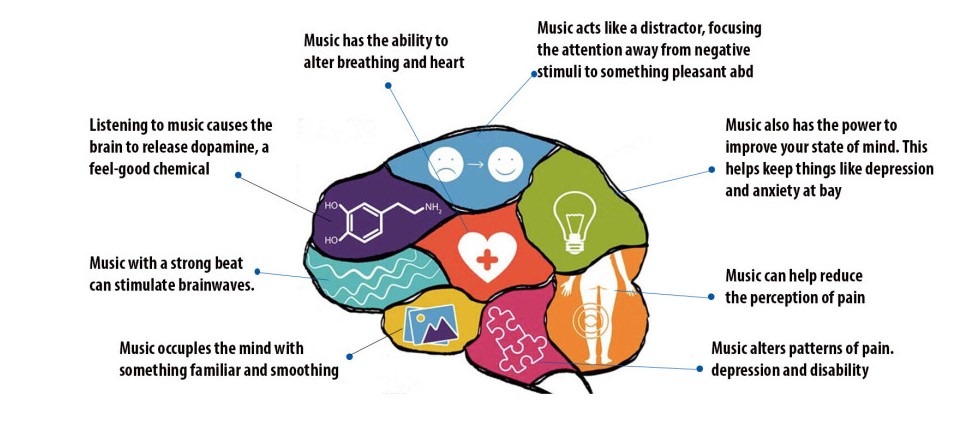Summary:
- Sound healing blends ancient wisdom and modern science for physical and emotional well-being.
- Methods include tuning fork therapy, singing bowl therapy, and binaural beats, each with unique benefits.
- Personalized routines and future advancements offer promise for integrating sound healing into holistic wellness practices.
Ancient cultures across Tibet, China, India, Latin America, Africa, and Greece have long practiced sound healing. It was and is still being utilized in ceremonies and instrumental in addressing various conditions, including:
- Anxiety and Stress: Through the use of calming music and specific frequencies, sound healing has been effective in reducing anxiety levels and promoting relaxation.
- Pain Management: Certain sound frequencies, such as those produced by Tibetan singing bowls or tuning forks, have alleviated pain and discomfort, offering a natural alternative or complement to conventional pain management techniques.
- Sleep Disorders: Sound healing techniques, such as listening to soothing music or binaural beats, have shown promise in improving sleep quality and aiding individuals struggling with insomnia or other sleep-related issues.
- Emotional Imbalances: Sound healing’s ability to evoke different emotions through music and vibrations has been harnessed to address emotional imbalances, providing a therapeutic outlet for processing and releasing pent-up emotions.
- Physical Rehabilitation: Sound frequencies and vibrations have been integrated into rehabilitation programs to facilitate the healing process, enhance circulation, and promote tissue repair, aiding in the recovery from injuries or surgeries.
Cultural and Historical Perspectives
Across cultures and throughout history, sound healing has demonstrated its efficacy in promoting overall well-being and addressing a wide range of physical, emotional, and psychological conditions.
You’ve likely felt it—the undeniable boost in mood or the calmness that washes over you when your favorite tune plays.
But what if these experiences are more than just psychological effects? Enter the world of sound healing, a practice that uses music and sound frequencies to improve physical and emotional health.
This intriguing field, blending ancient wisdom with modern science, reveals that sound is not merely a backdrop to our lives but a powerful tool for healing and transformation.
The Science Behind Sound Healing
Sound healing operates on the principle that everything in the universe, including our bodies, is in a constant state of vibration. When these vibrations are out of tune, it can lead to physical or emotional imbalance.[1]
Sound healing aims to restore harmony using specific frequencies and rhythms. Research shows that certain sounds and frequencies can:
- Reduce stress
- Lower blood pressure
- Improve sleep
- Decrease mood swings
- Enhance concentration
Types of Sound Healing
There are several methods of sound healing, each with its unique approach and tools. Some of the most popular include:
- Tuning Fork Therapy: Uses metal tuning forks to apply specific vibrations to different parts of the body, helping to release tension and energy, and promote emotional balance.
- Singing Bowl Therapy: Involves the use of Tibetan singing bowls, which produce sounds that invoke a deep state of relaxation, aiding in healing and meditation.
- Binaural Beats: A method that employs two slightly different sound frequencies played in each ear, leading the brain to perceive a third tone that encourages various states of relaxation and alertness.
The Role of Music in Emotional Healing
Music’s role in emotional healing is profound. It can evoke a wide range of emotions, from joy to sorrow, and everything in between. Listening to music can be a therapeutic experience, offering:
- A form of expression for feelings hard to put into words
- A sense of connection and universality
- An outlet for processing emotions
How Music Influences the Brain
Music’s impact on the brain is a hot topic in neuroscience. Studies have found that listening to music can:
- Stimulate the release of dopamine, the “feel-good” neurotransmitter
- Enhance neuroplasticity, the brain’s ability to adapt and change
- Improve memory and cognitive function
Sound Frequencies and Physical Health
Sound frequencies not only affect our emotions but our physical health as well.[2] Specific frequencies are known to promote healing, reduce pain, and improve overall well-being. For instance:
- 528 Hz: Known as the “Love Frequency,” it’s believed to repair DNA and bring about healing and peace.
- 174 Hz: Said to act as a natural anesthetic, reducing pain physically and energetically.
Table 1: Impact of Specific Frequencies on Health
| Frequency (Hz) | Benefits |
| 528 | DNA repair, peace, and healing |
| 174 | Pain reduction |
| 432 | Enhances mental clarity |
| 639 | Fosters interpersonal harmony |
Integrating Sound Healing into Your Life
Incorporating sound healing into your daily routine can be simple and enjoyable. Here are a few ideas:
- Listen to binaural beats while working or studying to enhance focus.
- Play Tibetan singing bowls at home to create a calming environment.
- Use tuning forks as part of a meditation or yoga practice.
Creating a Personalized Sound Healing Routine
To get the most out of sound healing, consider creating a personalized routine. This might involve:
- Identifying specific areas of your life or health you’d like to improve.
- Experimenting with different types of sound healing to see what resonates with you.
- Making sound healing a regular part of your wellness practice, much like diet or exercise.
The Future of Sound Healing
As interest in holistic health continues to grow, so does the exploration into the healing potential of sound.
Future research may unveil even more about how sound frequencies can be harnessed for health, potentially leading to new therapies and treatments.
The journey into the healing power of sound is just beginning, and its promise is as vast as the spectrum of sound itself.
Table 2: Sound Healing Practices and Their Benefits
| Sound Healing Practice | Benefits |
| Tuning Fork Therapy | Releases tension, promotes emotional balance |
| Singing Bowl Therapy | Induces relaxation, aids in meditation |
| Binaural Beats | Enhances focus, encourages relaxation or alertness |
As we go deeper into the science and art of sound healing, we uncover its capacity to not just heal but transform lives.
Whether through the ancient practice of singing bowls or the modern application of binaural beats, sound healing offers a harmonious path to wellness that resonates deeply within us all.
In this exploration of the healing power of sound frequencies and music, we’ve only scratched the surface. The potential for growth and understanding in this field is immense.
As technology advances and our grasp of the human body’s complexities deepens, the opportunities to refine and enhance sound healing practices grow.
This ongoing evolution promises to unlock new ways to mend the mind, body, and spirit through the fundamental yet profound medium of sound.

Personal Stories of Healing Through Sound
Anecdotal evidence and personal stories add a rich layer to our understanding of sound healing’s impact. Individuals from various backgrounds report significant improvements in their health and well-being after incorporating sound healing into their lives.
These stories not only provide inspiration but also help guide the scientific community in its research efforts, pointing to areas where sound healing shows promise and where further investigation is needed.
The Connection Between Sound Healing and Mindfulness
Mindfulness and sound healing are deeply interconnected. Both practices invite us to tune into the present moment and foster an awareness of our inner and outer environments.
Engaging with sound healing can enhance mindfulness practices by providing a focus for meditation and deepening the connection to the self.[3]
Similarly, mindfulness practices can augment the effectiveness of sound healing by cultivating openness and receptivity to the healing vibrations.
What connects us to everything is that our bodies and the Earth vibrate at natural frequencies, integral to health and environmental connection. Human cells vibrate at various frequencies, essential for cellular health and function.
Energetic and healthy cells resonate at higher frequencies, typically within the 62-70 MHz range, impacting our overall well-being. When cell vibration falls below 62 MHz, it may lead to mutation and illness, highlighting the connection between vibrational frequencies and health.[5]
The Earth resonates at about 7.83 Hz, known as the Schumann resonance, influencing biological rhythms and well-being.
Aligning our frequencies with Earth’s through meditation or sound therapy can improve mental clarity, emotional balance, and physical health, enhancing our natural vibrational harmony and connection to the planet.
Challenges and Considerations
While sound healing offers many benefits, it’s not a one-size-fits-all solution. There are challenges and considerations to keep in mind:
- Individual Differences: People react differently to sound frequencies. What heals one person may not affect another in the same way.
- Quality of Sound Healing Tools: The effectiveness of sound healing can depend on the quality of the instruments and recordings used.
- Integration with Conventional Medicine: Sound healing should complement, not replace, conventional medical treatments, especially for serious conditions.
Navigating the Sound Healing Landscape
For those new to sound healing, the variety of practices and tools available can be overwhelming. Here are some tips for navigating this landscape:
- Start small. Begin with one form of sound healing and observe how it affects you before trying others.
- Seek out reputable practitioners and high-quality instruments or recordings.
- Listen to your body and mind. If something doesn’t feel right, it may not be the right approach for you.
The Universal Language of Sound
Music and sound are universal languages that transcend cultural and linguistic barriers. This universality is a testament to sound’s inherent power to connect and heal.
Sound healing taps into this language, offering a bridge between the seen and unseen, the scientific and the mystical, the mind and the heart.
As we continue to explore and understand the healing power of sound frequencies and music, we stand on the brink of a new frontier in holistic health.
This journey is not just about healing the ailments of the body but also about nurturing the soul and fostering a deep, resonant connection with the universe.[4]
The Role of Community
The communal aspect of sound healing should not be underestimated. Group sound healing sessions, whether in person or online, can amplify the healing effects through shared intention and energy.
These gatherings foster a sense of belonging and support, essential components of healing and growth.
The exploration of the healing power of sound frequencies and music is a journey into the heart of what it means to be human. It’s a call to listen deeply, not just to the sounds around us but also to the silent whispers of our being.

As we tune into this profound source of healing, we discover that the harmony we seek outside is a reflection of the harmony within.
Expanding Accessibility
The democratization of sound healing tools and knowledge marks a pivotal shift in its accessibility. Today, digital platforms offer an abundance of resources, from guided sound meditations to high-quality recordings of healing frequencies.
This ease of access enables a wider audience to experience the benefits of sound healing, breaking down barriers related to geography, mobility, and socioeconomic status.
Leveraging Technology
Technology advances in sound healing include customized binaural beats apps, immersive virtual reality soundscapes, and therapeutic frequency wearables.
These innovations not only enhance the individual experience of sound healing but also offer new avenues for research and application.
The Integrative Approach
An integrative approach, combining sound healing with other therapeutic modalities, is gaining traction.
This holistic perspective recognizes the interconnectedness of mind, body, and spirit and the role of sound in nurturing each aspect.
By integrating sound healing with practices such as yoga, psychotherapy, and acupuncture, practitioners can offer a more comprehensive healing experience.
Collaborative Opportunities in Healthcare
The potential for collaboration between sound healers and healthcare professionals presents exciting opportunities.
Such partnerships could lead to the development of integrative treatment plans that include sound healing as a complementary therapy, potentially improving patient outcomes and satisfaction.
As the body of research grows, these collaborations could become more commonplace, signaling a shift towards a more inclusive healthcare model.
Ethical Considerations
As with any therapeutic practice, sound healing comes with its ethical considerations. Practitioners must navigate issues of consent, privacy, and professional boundaries with care.
Sensitivity cannot be overstated. Given that many sound healing instruments and techniques are rooted in specific cultural traditions, practitioners should approach these practices with respect and acknowledgment of their origins.
Misappropriating or commodifying sacred traditions under the guise of wellness not only disrespects those cultures but dilutes the authenticity and efficacy of the healing process. So, before you go banging on a gong and calling it ancient therapy, let’s take a moment to learn its story.
The DIY Trend in Sound Healing
With the rise of YouTube tutorials and Pinterest fails, it’s no surprise that the DIY trend has also hit sound healing.
Crafting singing bowls or tuning forks shows admirable self-reliance, but YouTube lacks the depth and cultural context that comes from years of study and practice.
However, for those simply seeking to incorporate a bit of sound-based tranquility into their lives, the DIY route can be a fun and accessible option.
Just don’t expect to become a sound healing guru overnight. Or, at least, not without a few hiccups—and perhaps a slightly annoyed family—along the way.
Doubt and the Skeptics
Skepticism towards sound healing is not uncommon, and frankly, it’s healthy. Questioning and critically evaluating any healing practice is essential for discerning its value and effectiveness.
However, approaching sound healing with an open mind might just turn skeptics into believers—or at least into individuals who enjoy a good nap during a sound bath.
Watch and listen to this video and see how the frequencies of sound affects you. Close your eyes, take three slow breaths in and out, and relax.
Be mindful of how you feel after this short session.
Charting the Future of Sound Healing
As we look to the future, the evolution of sound healing is boundless. With each stride in technology and a deeper understanding of the human condition, new dimensions of this ancient practice unfold.
Imagine a world where your daily commute is accompanied by personalized healing frequencies, or your smart home is attuned to your energy levels, playing sounds that uplift or calm as needed.
The possibilities are as vast as the frequencies that fill the universe.
In the end, the journey into sound healing is much like listening to a favorite album. You may come for one track but find yourself staying for the entire experience, discovering new nuances with every listen.
Whether you’re a devout practitioner, a curious explorer, or a staunch skeptic, the world of sound healing invites you to tune in and perhaps find a frequency that resonates with your soul.
And who knows? You might just find that the harmony you’re seeking has been within your reach all along, waiting to be played.
- www.ncbi.nlm.nih.gov/pmc/articles/PMC5871151/
- sageacademyofsound.com/science-of-sound-healing
- www.psychologytoday.com/us/blog/urban-survival/201907/the-healing-power-of-sound-as-meditation
- www.sciencedirect.com/topics/medicine-and-dentistry/sound-therapy





















